My Top 3 Must-Have Sprint Retrospective Templates for Continuous Improvement
My Top 3 Must-Have Sprint Retrospective Templates for Continuous Improvement
Introduction
After every sprint, preferably after the sprint review, most agile teams run a sprint retrospective. But using the same retrospective templates can become boring for your team members. The retrospective meeting can become one of those no one looks forward to.
I've written out the sprint retrospective examples in more detail but here are my top 3 sprint retrospective formats I use in our agile team.
1. The Lightning decision jam
The lightning decision jam is my favorite retrospective template. It is a versatile retrospective that can be used for many problem-solving meetings. I taught this template to my fellow scrum master, and he is using this template regularly in his scrum team.
This exercise allows the team to get themselves heard—even the shy team members. During this retrospective meeting, each team member works alone together. Writing their ideas and issues on (digital) sticky notes in silence.
The lightning decision jam consists of 3 phases. The sailboat, the 10-for-10 exercise, and the action board.
It is structured so you'll always have actionable tasks for the next sprint at the end of the meeting.
The sailboat
The sailboat is a straightforward exercise. After this exercise, the team reviewed what was helping them move forward and what was holding them back.
This sailboat has fewer features than when running the sailboat retrospective template. We are only focussing on the anchor and using the sail as a warm-up exercise for the team.
Wind in the sails
This is an icebreaker for the team members. We ask them:
What is giving us wind in our sails?
What is moving us forward?
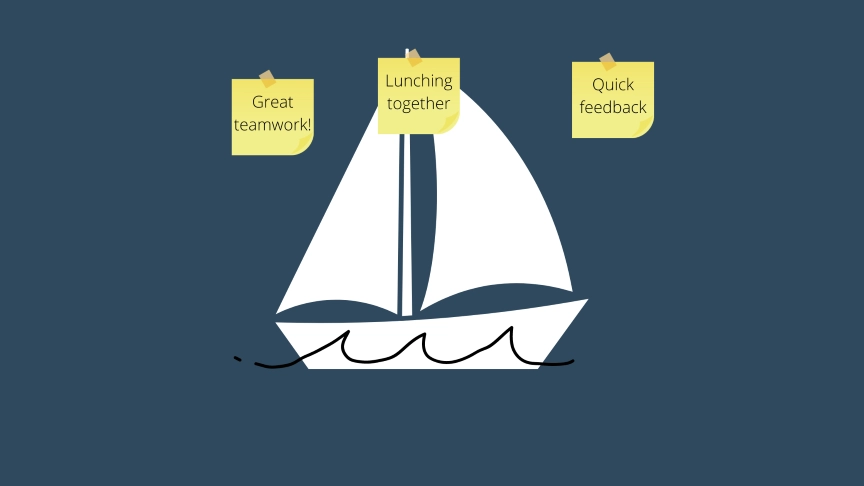
After they've written down their thoughts on a sticky note for each thought, each team member presents their sticky notes to the team.
The anchor
The second question the team focuses on is the anchor. They answer the following questions:
What is our anchor?
What holds us back from moving forward?
After a set amount of time, the team members stick up their anchors on the bottom side of the sailboat. No presenting to the group here!
Vote
Let the team members review the sticky notes on the bottom of the sailboat. Group similar topics together.
You can use a double-layered voting strategy to prioritize the issues.
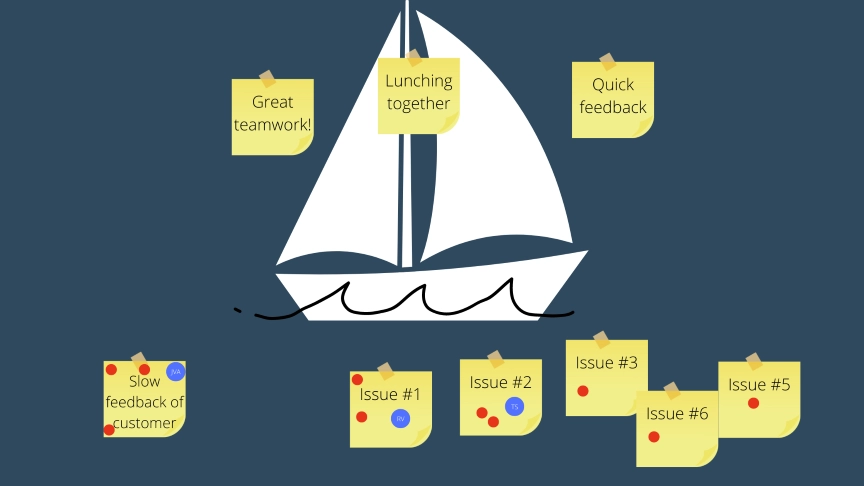
When the team voted, it's time to rewrite the problem statement into an opportunity question or 'How Might We'.
The 10-for-10
We take the opportunity question from the previous exercise and paste it onto a new whiteboard or flipchart.
Give the team time to brainstorm ideas around the opportunity question.
When the timer rings. It is time to post all of the ideas onto the whiteboard or flipchart.
Vote
Review the ideas on the board and group similar items together. Here you can use dot voting (or heatmap voting) to prioritize the ideas.
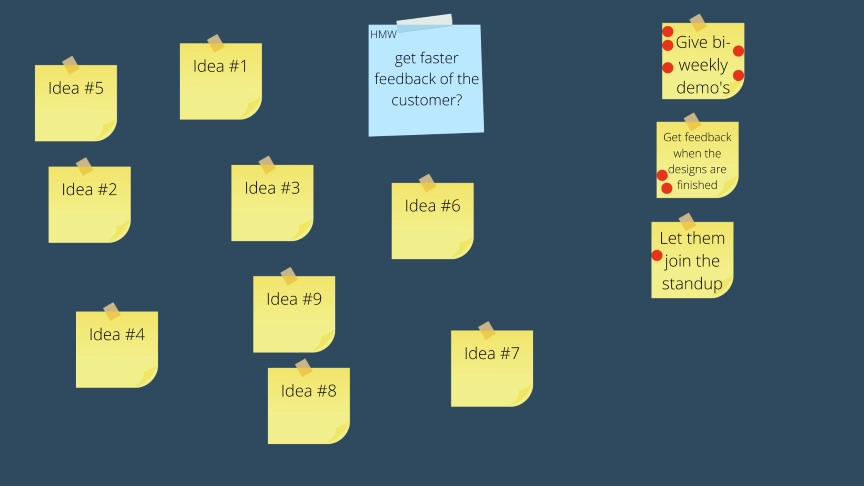
The effort impact scale
Take the top 5 ideas and bring them over to the action board.
Go for each idea over the effort for each idea.
Afterward, go over the impact of the ideas.
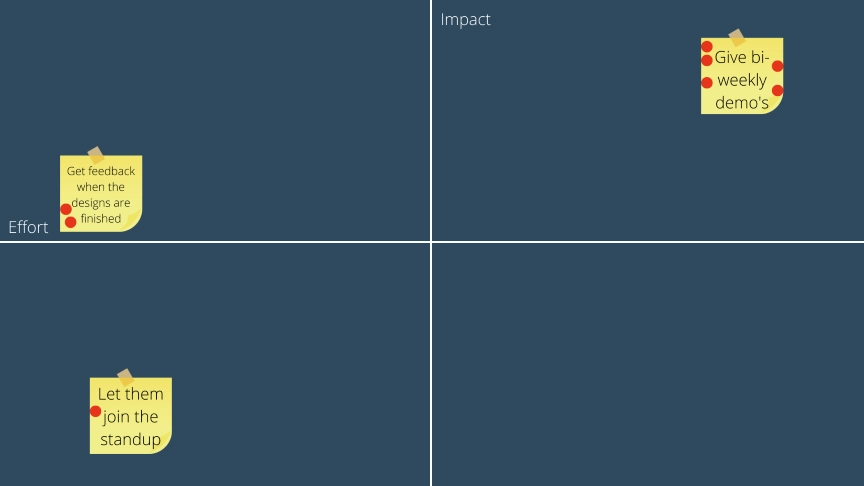
Take the top-left items and convert them to actionable tasks you'll do in the next sprint. This can be a task that should be done or an enhancement of the definition of done.
Take the top-right items and move them to the backlog.
2. Start, Stop, Continue
The start-stop-continue retrospective template is the first agile retrospective template I've used in my career. Being a new scrum master, this template was so straightforward the retrospective almost ran by itself!
The start-stop-continue sprint retrospective template consists of three columns. Start, stop, and continue.
This retrospective template is less structured than the lightning decision jam but is a great tool to guide the conversation in your team.
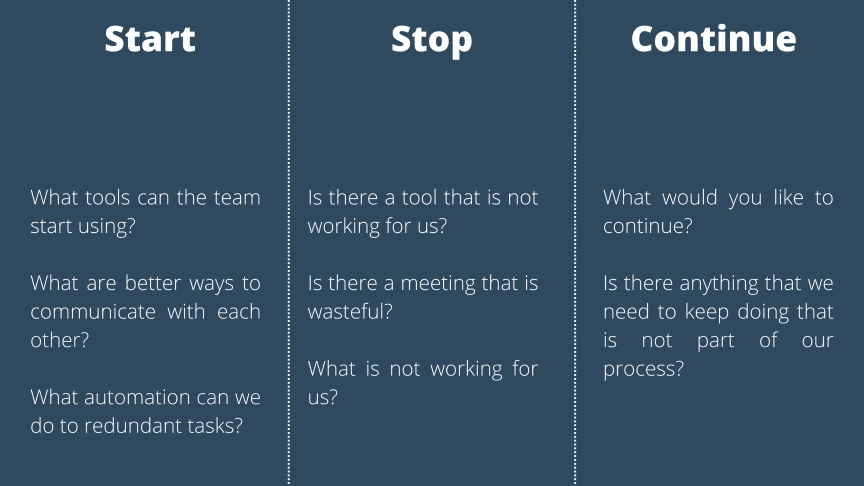
Start
These are activities that the team helps become more efficient. Where can they reduce waste using a new tool or communication method? These activities should positively impact the team and improve the team's performance.
Stop
These are activities that the team faces that are wasting time for them or are inefficient. These activities hurt the team's performance. Keep into consideration the technical and behavioral elements.
Continue
These are activities or experiments that the team tried out and that are working! So before you start this exercise, you'll need to gather the activities that are not part of the current process. These activities will become part of the team's core activities.
3. The sailboat retrospective
The power of the sailboat retrospective is in the way you visualize everything from the previous sprint. On the template, you can visualize the sprint goal as your focus point.
Running the sailboat retrospective, you and your team are trying to find how to get the boat to smooth sailing. Searching for risks they'll face, seeing what is working, looking for things that are slowing them down, and making sure the sailboat is heading in the right direction.
The sailboat retrospective consists of five elements. The sailboat, the sail, the anchor, the rocks, and the island (the focus point of the retrospective).
It gives you, as the facilitator, the perfect starting point to communicate the exercise through metaphors.

The sailboat
The sailboat represents the entire team and their processes sailing to their goal. You can use the metaphor: "Is the sailboat heading in the right direction?"
The island
The island represents the sprint goal of your team's last sprint. This is where the team wants to go.
The sail
What is giving us wind in our sails to go to the island? What helps us move forward?
The team focuses on the good things that are happening and are helping them achieve their goals. What efforts move the team forward to their sprint goal?
The anchor
What is holding us back from going to the island?
Here the team focuses on the bad things that they are doing. They'll look for impediments and issues they've faced.
The rocks
What are the rocks we face when going to our island?
The rocks represent the potential risks they'll face. This part of the exercise helps them to be proactive about oncoming risks.
Bonus templates
The Continious Delivery Workshop
This workshop is focused on our cycle time. We visualize our development process and brainstorm where we can make improvements by finding ideas from others. Finally, making an experiment on how we can improve our cycle time and, thus, our release process.
Rose, thorn, bud
The rose bud thorn template is an exercise that works more on the touchy-feely side of the participants. It'll expose common themes that each team or group member struggles with.
This retrospective is more focused on the general feeling of the team and has no specific focus point for the retrospective. It's good to use with newer agile teams or teams that want to do a mindful session.
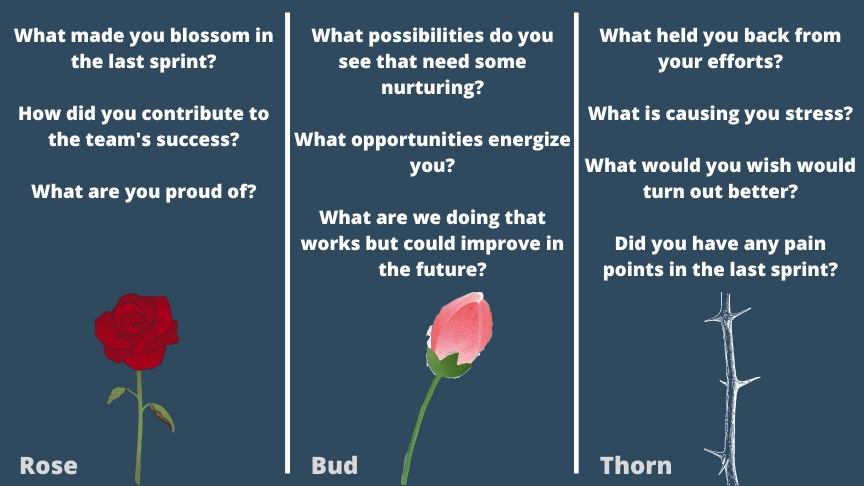
The rose
During the rose exercise, we will reflect on the positive feedback. We'll create a positive highlight to our efforts.
We'll answer some of the following questions:
- What made you blossom in the last sprint?
- How did you contribute to the team's success?
- What are you proud of?
The bud
We will look for improvements during the bud exercise to create a potential rose in the next period. We can see if there is an upcoming project we can try.
We'll answer some of the following questions:
- What possibilities do you see that need some nurturing?
- What opportunities energize you?
- What are we doing that works but could improve in the future?
The thorn
The thorn exercise will look for things that are hurting our team members. This is the negative part of the retrospective.
We'll answer some of the following questions:
- What held you back from your efforts?
- What is causing you stress?
- What would you wish would turn out better?
- Did you have any pain points in the last sprint?
Conclusion
I've shown you some templates you can use for your next sprint retrospectives. Change these templates for your next sprint retrospective meetings and see the participation of your team members skyrocket. When the whole team is on onboard, it'll help the team's continuous improvement.

